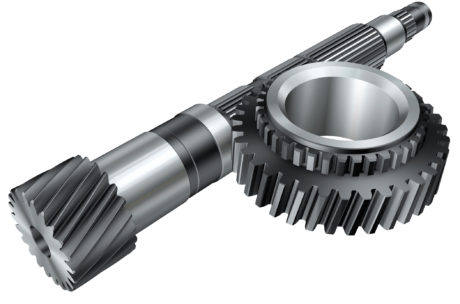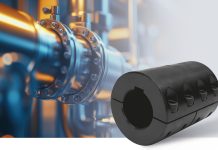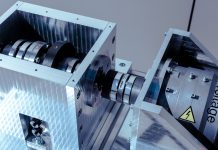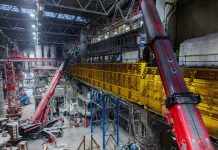In the following article, we are treating the fundamental aspects to be known for the error-free alignment of two shafts.

Aligning two shafts means to make them share the same rotation axis, precisely as it would happen if they were a single shaft. This definition obviously does not include those cases where a given misalignment is admitted between the two shafts, as it happens when they are connected by a universal joint or a toothed coupling and so on …Shafts can have a different outer shape from the straight cylindrical one, due for instance to their weight, to the constraint condition or to the thermal expansion; this requires an assessment of the shaft alignment in their coupling point. Besides, we must consider that operation conditions influence the alignment, just think of the case in which the shafts are integral with unbalanced masses changing their shape, or the heat causing their expansions. Therefore, it is necessary to measure the alignment in the closest possible situation to the operation one. Aligning two shafts does not mean aligning the two semi-joints mounted on the respective shafts, the front surfaces of joints, in fact, are neither always accurately machined nor orthogonal to their rotation axes. We cannot avail ourselves of this device to reach the desired alignment. In the case of shafts with big distance among the supports, perhaps also composed by several truncated shafts, the shaft line is probably curve, whose camber might be of even some millimetres; this does not mean that the shaft is misaligned! As already said, the alignment consists in the coincidence of the same rotation axis, even if this takes a curvilinear course.
Misalignment factors
In how many ways can two shafts be misaligned? There are parallelism and angular misalignments or both simultaneously; in the latter case, if the rotation axes fall into the same plan, the misalignment is coplanar otherwise it is skew. The most general case is the skew misalignment. The method currently used to measure the misalignment existing between two shafts consists in measuring the displacement and opening values on the vertical and vertical and horizontal plan, then four values overall.
Alignment methods
Due to the importance of assuring a good alignment between two shafts, various alignment methods have been developed, some simple and approximate and others more complex and precise. We are here surveying the main methods in use, as follows.
Soft foot – It is the case of a machine hyperstatically bound to the floor, for instance if it rested on four feet, only three would be freely supported by the ground while the fourth would remain detached. The operating machine would occasionally bring the fourth foot in contact with the soil, detaching another. That situation would be inadequate for the integrity of the installation. On the other hand, if the fourth foot was forcedly anchored to the soil, as noxious stresses on the machine would emerge. The soft foot is corrected by interposing wedges of suitable thickness between the foot and the soil; in case of angular soft foot, a cuneiform wedge is necessary.
Alignment with straightedge – It is a very simple method consisting only in aligning the outer cylindrical capacities of the two semi-joints. It is performed by means of a straightedge or other equivalent instrument. This operational procedure leads to align the joint, not necessarily also the shafts, except for the cases in which the joint is stiff and the semi-joints are integral with the respective shafts.
Alignment with thickness gauge – It is a method that, as in the previous case, aligns the joint instead of the shafts. However, it is a valid method especially when the semi-joints are machined from a single piece with the shaft, like for instance in the turbine case.
Alignment with comparator – It is the most diffused alignment method, suitable for flexible and semi-flexible couplings, too. There are several variants of this method with one or two comparators, side – front, opposite comparators; these methods can make use of the graphic method or of the calculation to carry out manoeuvres resulting in the alignment. Although the use of comparators in the shaft alignment has represented a notable progress to the ends of precision, however remain some factors that negatively influence the measurement, to which the executor must pay utmost attention for not frustrating the operation itself.
Laser alignment – More recent and evolved method than the previous ones that, even if inspired by the alignment with comparators, eliminates some of its inconveniences and automates its operation. The use of light beams, instead of metal rods, and of electronic equipment, instead of mechanical instruments, eliminates some of the possible error sources mentioned about the alignment with comparators. The benefits that derive from the use of PC-like electronic equipment are notable indeed; for instance, the calculations or the graphs to which we must turn in the alignment with comparators, in this case are directly performed by the system. Images reproduced on graphic screens guide the operator in the execution of alignment manoeuvres; if the instrument is certified, the measurements provided by it and consequently the alignment itself are certified, too. The laser alignment system actually solves a problem posed in mathematical terms, that is to say a problem of analytic geometry that can be formulated as follows: “find the motions to be executed to make two skew axes coincide in the space”. Such axes are obviously the rotation axes of the two shafts before the alignment.
There are two typologies of laser aligners:
- With single laser – the beam emitted by the emitter/receiver laser, fixed on a shaft, is reflected by a receiver or by a prism positioned on the opposite shaft, to return to the starting laser;
- With two lasers – where each laser, one per each shaft, emits a beam that is received by the receiver on the opposite shaft.
Operating with a single laser grants notable advantages:
- You have a single laser to be electrically powered, then a single cable or no cable in case of battery power supply;
- A single laser to be regulated to perform the measurement and likewise a single laser to be periodically calibrated;
- Possibility of widening the measuring range, resulting in the capability of carrying out measurements also on strongly misaligned shafts;
- Finally possibility of rotating the shafts individually, i.e. uncoupled, facilitating the operations with big-size shafts.

Advantages achievable with aligned shafts
Why should we align carefully two or more rotary coupled shafts? Practical applications have widely demonstrated the damages caused by misaligned shafts, even their premature failure, but we are going to see more in detail the advantages more easily surveyed. Two shafts connected each other more or less stiffly, but rotating around different axes, are subjected to variable mechanical stresses, induced just by that anomalous kinematic configuration; an energy dispersion in the heat form is then generated. The imperfect kinematic operation, like the one between misaligned shafts, stresses both shafts themselves and the connected parts, resulting in sudden malfunctions and breakdowns. Bearings are notably stressed by the misalignment and therefore their service life is shortened. The misalignment is source of vibrations for the machines affected by it, with all related consequences: quality defects, reduction of the work speed, idle times for excessive vibrations, just to mention the most evident effects. The vibration measurement is also a very valid method to assess the misalignment of shafts with operating machine. Currently the shaft alignment is carried out in very fast and precise manner, thanks to the devices at our disposal; nevertheless, it is not a common maintenance practice, yet, to control the misalignment maintenance in time and not only at the machine installation time. The technology and the knowledge from which we benefit today allow not only aligning shafts in standstill state but also foreseeing misalignments in operation and then executing the alignment taking them preventively into account.



